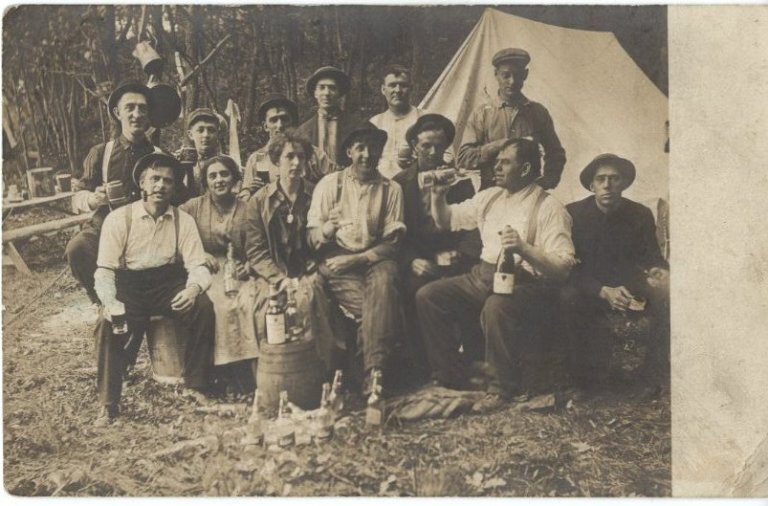Shakopee Brewery
The first brewery in the Minnesota River Valley, Shakopee Brewery opened in 1855. The facility was founded by H.H. Strunk (also the proprietor of Strunk Drug). Strunk owned Shakopee Brewery until, interested in other pursuits, he sold the business to Andrew Winkler in 1863, who retained ownership until his death in 1870.
After 1870, Winkler’s widow, Mary, continued to manage brewery operations. Five years later, she married a German Master Brewer named Hubert Nyssen and the two continued to run Shakopee Brewery together.
Unfortunately, the building was destroyed by fire in 1885. Fire was a huge concern in early brewing due to the dangerous combination of wood or coal heating and the dry, airborne dust produced when grain was industrially ground. Luckily, the family had enough capital to invest in rebuilding the facility. Shakopee brewery remained a fixture of the community until prohibition forced it to close in 1920.
You can still see the ruins of the brewery today, along the Minnesota River bike path, on the northwest edge of the city.
Shakopee Brewery, 1907. Photograph from the SCHS Collections
Hubert Nyssen, around 1920. Photo from the SCHS Collections.
Schutz and Hilgers Jordan Brewery
The Jordan Brewery was founded in 1866. Like the Shakopee Brewery, it was started by a prominent local businessman – in this case Frank Nicolin. The structure of Jordan brewery was built to last with limestone and brick walls more then 3 feet thick. Nicolin sold the building soon after it’s opening, and in 1867 it took on the name Sand Creek Brewing, run by partners Sebastian Gehring and Frank Paier, who ran the business for almost 20 years. In 1885 they decided to sell to Peter Schutz and William Kaiser. Kaiser left the partnership, and by 1902 the facility was owned jointly by Peter Schultz and Peter Hilgers, whose names have remained with the brewery building ever since.
Like breweries around the country. Schutz and Hilgers closed in 1920, but reopened immediately upon prohibition’s repeal in 1933. At its height, Schutz and Hilgers brewed 40,000 barrels of beer annually and distributed to seven states.
In 1946 the brewery facilities were bought by Mankato Brewing Company, but they were soon forced to shut down due to financial difficulties. Finally, in 1954, the building caught fire during construction work, and nearly burned to the ground. The ruins were left vacant for many years until the city considered demolishing the property. Today, it is listed on the National Register of Historic Places, and has been refurbished into retail property.
Schutz and Hilgers Brewery, around 1940. Photograph from the SCHS Collections.
Lable from Schutz and Hilgers, around 1940. From the SCHS Collections.
Kokes Brewery, New Prague
Kokes Brewry was started by brothers-in-law Thomas Kokes and Albert Minars in 1884. Kokes, like many other early brewery owners, was a prominent local businessman who also owned a general store. Located at the corner of Second Avenue NW and Fifth Street N, the brewery advertised itself as “using clear hops and malts” and having a modern “steam operated” plant. Minars left the partnership in 1887, but Kokes remained an active owner for many years. The brewery was a prominent local employer, and delivered barrels to many small communities nearby New Prague.
When prohibition hit in 1920, the facility switched to selling soft drinks and malted non-alcoholic cereal beverages. Unfortunately, this new business model was not as profitable, and the business closed in 1931. Today, the historic building houses apartments.
1891 plat map of New Prague. Kokes Brewery is marked with a black square, in the upper right-hand corner.
Schmitt Brewery, Belle Plaine
Schmitt Brewery was opened by Albert Swinger in 1860. It cost $500.00 to build, and was located Northeast of town along what came to be known (aptly) as brewery creek. In 1866, Schmitt Brewery fell victim, like many other early breweries, to a fire, and Swinger was forced to rebuild.
Ownership of the brewery fluctuated after the fire. City records list B. Osterfeldt as proprietor in 1870, but Christian Schmitt purchased the brewery in 1871.
In 1877 the building burned down yet again and was rebuilt by Schmitt. For many years, Schmitt brewery was a local business, with a capacity of 10 barrels per day. Schmitt began to expand, increasing the capacity to 500 barrels per year and starting a bottling line, but his health was failing. In 1905, Schmitt passed away, leaving the brewery to his sons. It finally closed in 1916 after being outsold by competition from larger, regional brewing facilities.
Schmitt Brewery around 1900. Photograph from the SCHS Collections.
Written by Rose James, SCHS Program Manager
































